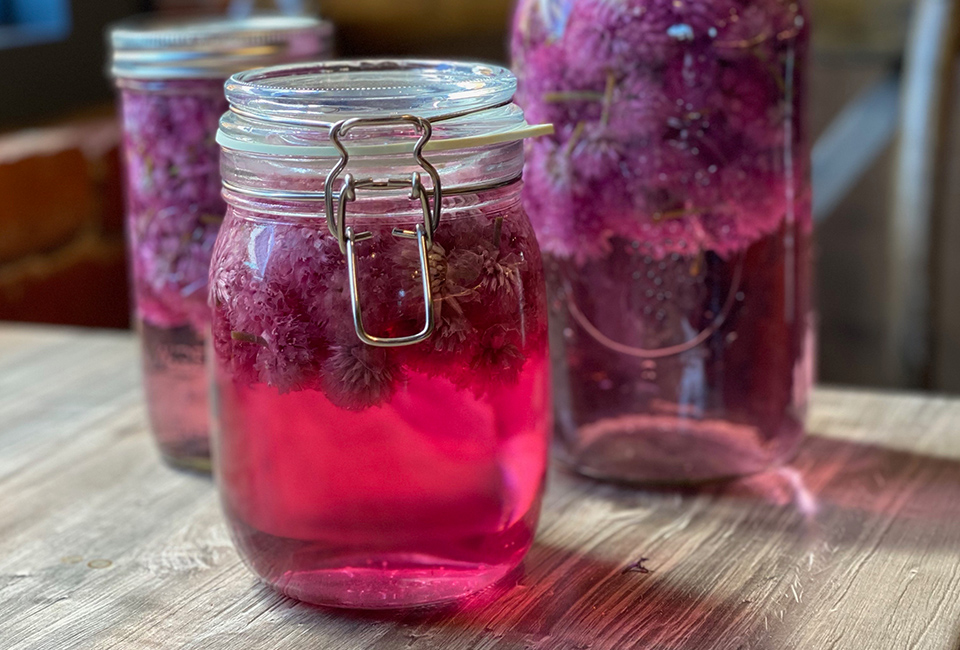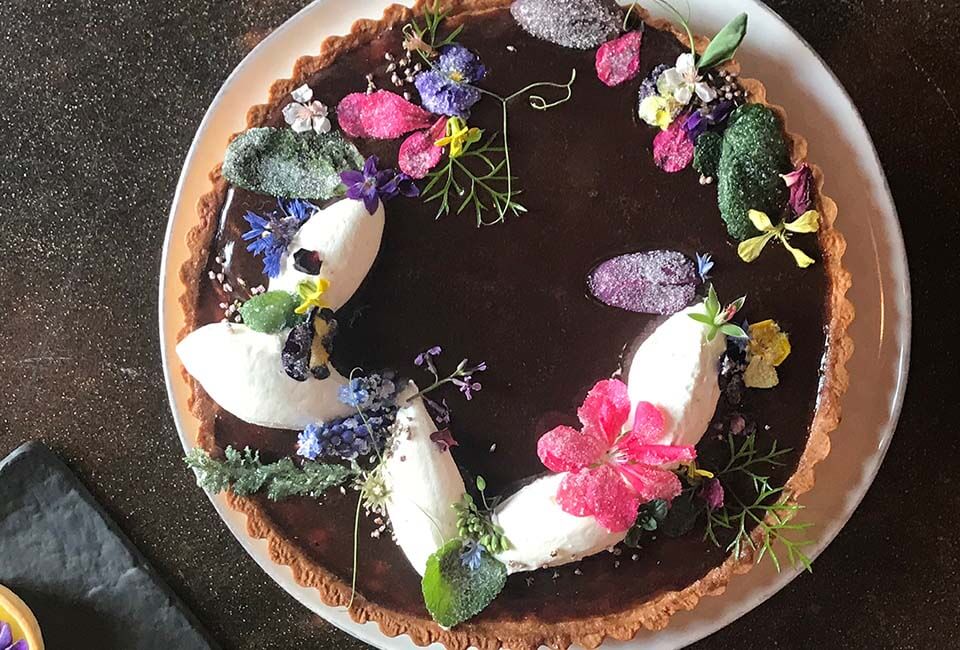 Family size Frito Pie!
Family size Frito Pie!
Childhood Home and Frito Pie
by Chef Deb Traylor
I’ve always been a Texas girl, a proud seventh generation Texan, and I’ve loved my state and the people who live there. But when I was younger I spent a lot of time dreaming of faraway places, and of people and food that were far removed from my hometown. I’ve moved around quite a bit since then, met all manner of people and learned about every kind of food I came across.
But it wasn’t until we began planning our menus for Ginger and Baker’s bakery and restaurants that I realized how much my food sensibilities were founded by the neighborhood and people I grew up with. I may be trained in French cooking and have fallen head over heels in love with Colorado, and Fort Collins’ farm-to-table abundance in particular, but everything I do has a small thread of the Texas Gulf Coast running through it.
I grew up in a fairly small town, a place called Flour Bluff. Most people have never heard of it, but if you’ve ever found yourself headed to the beaches of Padre Island and you’ve driven past Corpus Christi, then you’ve driven through my hometown. (How my town got its name is another story, you can read about it after the recipe.)

There’s uniqueness about the particular group of streets that my family called home for over 20 years. The neighborhood was located right behind the baseball field and high school. A group of small modest homes filled with working class parents and an unusual number of kids for just three short streets. Somehow we all ended up on the corner of Tulane and Juniper at the Morgan’s house where they had a skateboard ramp right next to the street. If anyone’s parents ever wanted to find their kid, all they had to do was look on that corner.
We had the Suerth’s, the Lowry’s, the Number’s, the Mabry’s, the Pelton’s, and many more. Easily 40-plus kids, walking across a foggy field every morning to get to school. When we all could drive, we’d hop in our cars and drive the one block, yes ONE, to school. It was a rite of passage. It’s with this group of kids that I remember things like going to football and baseball games, perpetually trying to stay out of trouble (note to my daughters… I never got into any trouble.😉) running back and forth to each other’s houses, and saving up our change for a Texas concession staple, Frito pie.
Frito Pie is probably the least processed and possibly good-for-you concession food you can find. Fritos are made with just cornmeal, salt, and water… no preservatives, no stabilizers and no sugars. Yes, they are fried, but who cares? The chili, if made correctly, is simply beef, onions, dried chilies and spices. It can be topped with any combination of chopped onion, tomato, jalapeños and cheese. Wholesome or not, it is, without a doubt, a delicious childhood memory in an easily portable serving container.
Notes and Comments:
This is a “shortcut” Texas chili recipe. No self respecting Texan would dare make a chili this quick, but I am doing so for convenience. You can also sub your favorite chili recipe or even used canned in a pinch. We used whole toasted dried chilies for this recipe, but you may certainly sub 2 Tbsp. ground chili powder. Try to use a variety of chilies if you can, it will offer more complexity and depth of flavor.
We used ground beef instead of chunks of chuck for convenience. We added a little tomato paste for sweetness, and lime for acid to balance out the flavors. I’m always trying to balance salt, sweet, acid and piquancy, so the tomato paste and lime juice help round out the flavors. No beans were added, but if you want to stretch the recipe with black, kidney or pinto beans, feel free to do so.
Frito Pie
- 1 recipe Quick Texas Chili or 1-2 cans chili (we like ‘Wolf’)
- 4-6 individual bags of Fritos, or 1 large bag for “family size” Frito Pie
- chopped white onion
- grated sharp cheddar cheese
- sliced jalapeños
- chopped tomatoes
- sour cream
Quick Texas Chili
- 2 ounces (6-8 chilies) dried, whole guajillo or pasilla chilies, or a combination of both (or sub 2 Tbsp. chili powder)
- 2 tsp. ground cumin seed
- 1 tsp. smoked paprika
- 1/2 tsp cayenne (optional)
- 1 tsp. freshly ground black pepper
- 1 tsp. Mexican oregano
- 1 Tbsp. kosher salt
- 3 tbsp. lard, vegetable oil, or bacon fat
- 2 1/2 pounds ground chuck or ground beef
- 1/2 cup finely chopped onion
- 3 large cloves garlic, minced
- 2 cups beef stock or canned low-sodium beef broth, plus more as needed
- 2 cups water, plus more as needed
- 1/2 – 1 cup Shiner Bock, or similar beer
- 1 tbsp. tomato paste
- 2 tbsp. masa harina (corn tortilla flour, for thickening the chili)
- juice of 1 lime
Toast chilies over a flame or place the chilies in a straight-sided large skillet over medium-low heat and gently toast until fragrant, 2 to 3 minutes per side. Don’t let them burn or they’ll turn bitter. Place the chilies in a bowl and cover with boiling water. Let them rest 15-30 minutes turning once or twice.
Drain the chilies, reserving 1 cup of liquid. Split the chilies and remove stems and seeds (a brief rinse helps remove seeds, but don’t wash away the flesh). Place the chilies in the bowl of a blender and add the cumin, paprika, cayenne, black pepper, oregano, salt and 1/4 cup reserved chile liquid. Purée the mixture, adding more liquid as needed to form a smooth paste. If using chili powder, purée chili powder, spices and 1/4 cup warm water in a blender. Set the chile paste aside.
In a large pot or Dutch oven, heat the lard, bacon fat or oil over medium heat. Add the onions and brown for 3 minutes. Throw in the garlic and cook for another 3-5 minutes. Remove onions from pan and set aside.
Add ground chuck or ground beef to the pot and cook until lightly browned, stirring occasionally, about 5 minutes. Add the chile puree, onions and beer, and reduce for 5 minutes. Add tomato paste, stock, and water and bring to a boil, then reduce heat and simmer 45 minutes.
Stir the masa harina into the chili and cook for 10 more minutes. Taste and adjust seasonings, if needed. Add salt, pepper and lime juice. Serve over Fritos with your choice of toppings.
Flour Bluff
My hometown of Flour Bluff received its name from a pastry war between Mexico and France. How very fitting I was raised in a place founded on a pastry war!!
Flour Bluff, at the tip of Corpus Christi Bay, received its name from an incident in the pastry war between France and Mexico. The pastry war began in 1838 because Mexico had refused to pay some debts to the French People who were living in Mexico. One of the men asking for repayment was a French baker whose bakery shop had been robbed by Mexican soldiers during a celebration of some kind. The French government wanted Mexico to pay the expenses for the robbery.
The Mexican government refused to pay the French so the French sent a fleet of ships off the coast of Veracruz, Mexico and declared a blockade of all Mexican ports from the Yucatan to the Rio Grande. Therefore, trade between Mexico and the rest of the world was stopped. Merchandise to be sent to Mexico was dropped at the port and then transported to the Rio Grande.
During the war, Texas became afraid that France would try to close the Texas ports due to the smuggling. A Texas militia was sent to Corpus Christi Bay to put a stop to all smuggling into Mexico. At this time, the Mexicans made an unexpected visit to the Bay of Corpus Christi and dropped about a hundred barrels of flour upon the beach. Thus, the name “Flour Bluff” came into existence. – info courtesy of the Flour Bluff Independent School District.




